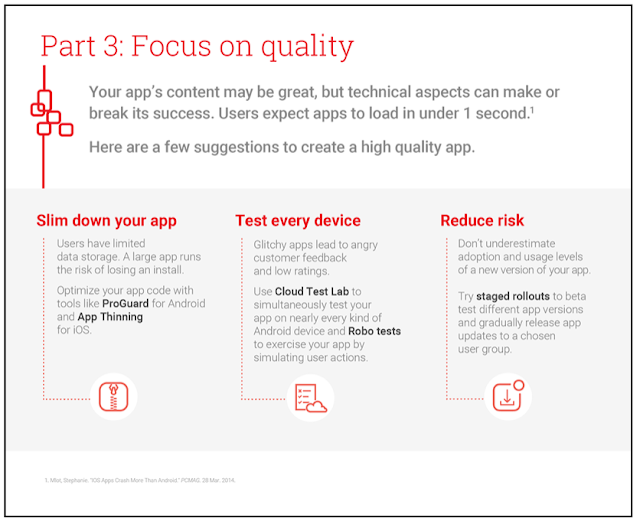Mobile Bootcamp Part III: Focus on quality
At this point, you’ve read our recommendations for growing your app’s audience and keeping users engaged. But there are technical aspects, too, that can make or break your app’s success. Speed, for example, is crucial -- users expect apps to respond in under one second.
Yesterday, we gave recommendations for attracting, engaging, and retaining your users. Continue reading today to learn tips from Dev Gogate, Mobile Solutions Consulting Manager at Google, on providing your users with a high quality app.
- The smaller the app size, the better: Users have limited bandwidth and data storage, so a large app runs the risk of losing an install. App stores impose size limits and will only deliver apps under a certain size over cellular connections; Google has a 50MB limit for each APK (but allows 2GB expansion files for supporting media) and Apple limits app size at 100MB. Use the ProGuard tool to optimize your Android code and enable Resource Shrinking to remove unused and unneeded resources from dependency libraries. App Thinning offers a similar solution for decreasing app size on iOS.
- Build apps that use device resources optimally: Building apps without taking into account how display interacts with hardware components can drain precious resources, such as battery life. According to Dev, "App performance is critical! A badly designed app can drastically and negatively impact the the user's perception of the app's usability and will surely lead to an uninstall." Dev recommends compiling a list of metrics for your apps to perform against and then running tests. This YouTube Android performance channel and Google+ community offer excellent tips on building high performing apps.
- Ensure your app works across devices: Failing to catch a bug or crash that only impacts some devices quickly leads to angry customer feedback and low ratings. Dev recommends using Cloud Test Lab to simultaneously test your app on nearly every brand and model of Android devices and across multiple languages, screen orientations, and Android API versions. Dev’s expert tip: Even if you have not written any instrumentation tests for your app, you can use Robo tests to exercise your app by simulating user actions.
- Use A/B testing to get real user feedback: Dogfooding your app provides early insight into how users interact with your app and how it behaves beyond the test lab. Beta testing, on the other hand, gathers feedback from an enthusiastic audience. Since this testing is customer-facing, ensure the process is simple to ensure high user participation. Both of these tests gives you early feedback from users before widely releasing your app.
- Launch new app versions in phases and closely monitor: Don’t underestimate the number of users who may adopt a new version of your app and their levels of usage. Dev recommends using staged rollouts, which allow you to beta test different app versions and gradually release app updates with a chosen user group. The Cloud Test Lab provides access to virtual devices that give rapid feedback during development, as well as physical devices that pinpoint issues found on real, physical devices.
Creating a high quality app is essential for building and maintaining a loyal user base. Follow Dev’s recommendations to optimize your app quality and stay posted for our post tomorrow on ways to effectively monetize.

 |
Posted by Danielle Landress Associate Product Marketing Manager, Publisher Marketing |

